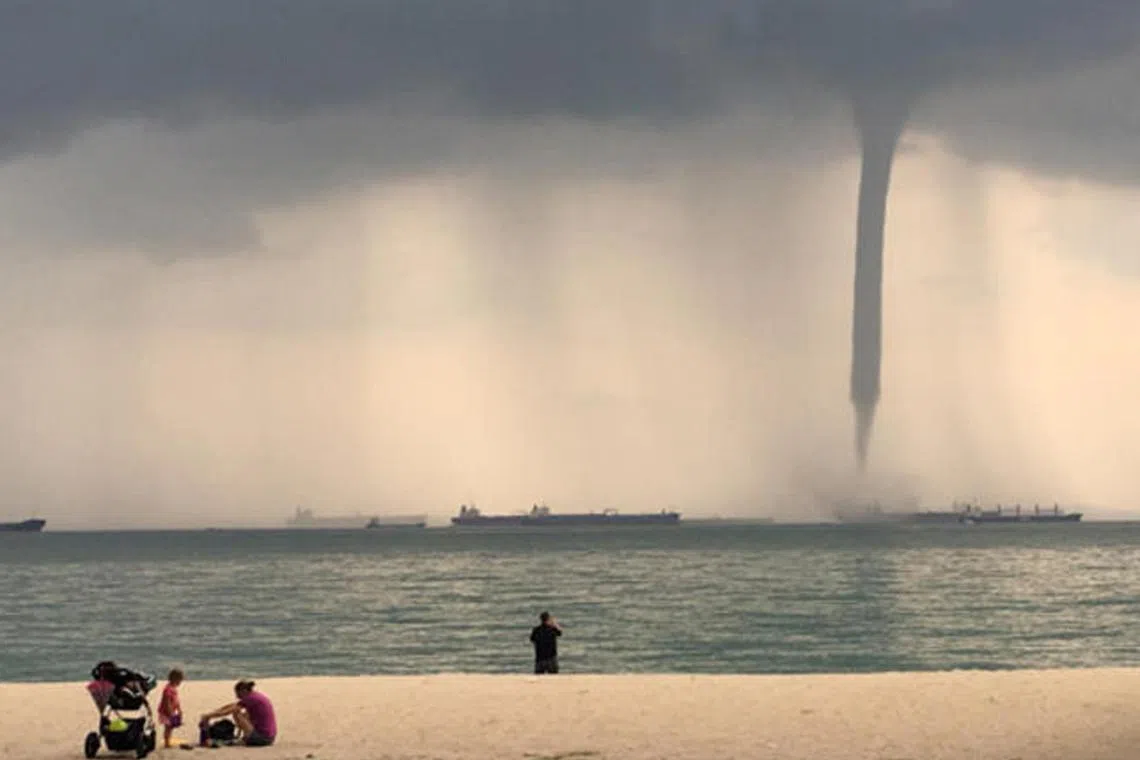ST Explains: Why is February the windiest month in Singapore?
Sign up now: Get ST's newsletters delivered to your inbox

Howling winds have been heard occasionally over the past few weeks during the north-east monsoon season, which typically enters its dry phase this month.
ST PHOTO: LIM YAOHUI
Follow topic:
SINGAPORE – It might be time to try kite-flying or put out wind chimes, as February is known to be Singapore’s windiest month of the year.
Howling winds have been heard occasionally over the past few weeks during the north-east monsoon season, which typically enters its dry phase in February.
The average wind speed in February is 2.8m per second, while Singapore’s average wind speed across the year is around 2m per second. January is the second-windiest month of the year here.
The Straits Times speaks to the Meteorological Service Singapore (MSS) and a weather and climate expert to find out what makes February the Republic’s breeziest month.
Why is February Singapore’s windiest month?
This is because of the north-east monsoon, which reaches peak maturity here in February, said Dr Koh Tieh Yong, who co-chairs the Asian-Australian Monsoon working group under the World Climate Research Programme.
During the monsoon season – which typically lasts from December to early March – the winds blow predominantly from the north or north-east.
Winds tend to be stronger in January and February due to episodes of surges of north-east winds, said MSS, which is under the National Environment Agency.
In the northern hemisphere’s winter season, bursts of cold air from northern Asia rush southwards into the South China Sea and towards the tropics.
This sudden surge of cold air is called a monsoon surge. These surges bring prolonged rain and strong winds to Singapore during the wet phase of the monsoon season in December and January.
Such surges occur in February as well, but without the deluge, as the monsoon is in its dry phase. The monsoon rain belt moves south to Java, Indonesia or northern Australia.
“Surges that occur during this period can still bring strong winds to Singapore, but these may not be accompanied by rain. As such, February is usually windy and relatively dry on most days,” said MSS.
During a monsoon surge event, average wind speeds can reach up to 10m per second or more, which is equivalent to 35kmh.
Dr Koh added: “Around February, the surface pressure in Asia’s interior intensifies to a maximum due to the prevailing cold winter condition and drives most strongly the wind towards us. In January, (the monsoon) is near maturity and so January’s wind strength is not far behind.”
How windy was it during the January 2025 monsoon surges?
Two monsoon surge events took place in January – the first between Jan 10 and 13, and the second between Jan 17 and 19. The first episode exceeded the country’s average monthly rainfall for the month.
As at Feb 5, the highest average wind speed in 2025 was 39.4kmh, recorded in Seletar on Jan 12 and 17 during the two surge episodes, said MSS.
The highest wind gust so far was 64.8kmh, recorded in Seletar and Changi on Jan 12.
Which other weather phenomena lead to strong winds here?
Sumatra squalls – an organised line of thunderstorms that develops over the Indonesian island of Sumatra or the Strait of Malacca – can also be associated with strong wind gusts.

Shelf clouds observed in Singapore’s skies, which is a characteristic feature of a well-developed Sumatra squall.
PHOTO: METEOROLOGICAL SERVICE SINGAPORE
During a squall on Sept 17, 2024, which affected more than 300 trees islandwide, a maximum wind gust of 83.2kmh was recorded at East Coast Parkway. A wind gust usually lasts less than a minute.

A large water spout was seen off East Coast at around 4.30pm on Aug 6, 2016.
PHOTO: STOMP
Waterspouts, or tornado-like funnels associated with intense thunderstorms over the sea, can reach speeds of up to 28kmh. The funnel is formed by water droplets in a rotating vortex of air.
Which parts of the country tend to be more windy?
Storm gusts hit the strongest on the Southern Islands and along exposed coasts or on elevated terrain, especially in the west, said Dr Koh. These areas include Tuas extension, Jurong Hill and Kent Ridge.
These parts also face the direction of Sumatra squalls that are approaching, he added.
Winds are generally stronger in coastal areas and over the sea than over land because in those areas, there is less friction to resist air flow, said MSS.
Daytime winds tend to be stronger than nighttime winds. But during surges, winds could also be strong at night, added the Met Service.
What kind of impacts do strong winds have?
A thunderstorm on March 30, 2018, came with a strong wind gust of 133.3kmh, causing substantial damage to farms in the Lim Chu Kang area, with one worker injured.
Chicken farms and plant nurseries, among others, suffered damage, with some chicken houses left flattened. The storm ripped the roof off a frog enclosure at a fish and frog farm, and also broke water pipes and electric cables, cutting off the farm’s water filtration system.

Hundreds of chickens belonging to then Chew’s Group in Lim Chu Kang were left without shelter after at least four large coops were battered and flattened by strong winds on March 30, 2018.
PHOTO: ST FILE
Dr Koh said: “Ill-attached roofs, especially canvas, zinc or tin roofs, can catch strong winds and blow off. In rare instances, they can also uplift any small structures to which they are attached.”
In December 2022, strong wind gusts swept fifteen empty containers at Keppel Terminal into the sea.

Empty containers floating in the sea at Keppel Terminal after falling into the water due to strong winds in December 2022.
PHOTO: MPA
Felled trees and toppled rubbish bins are not uncommon during heavy rain and strong winds.
What’s the cause of howling winds in Singapore?
Basically, winds howl because moving air splits and blows around obstacles, said Dr Koh.
“One can imagine the air as an immense invisible fabric that tears upon meeting obstacles in order to wrap around and slip past them. The ‘tears’ generate shocks in the ‘fabric’. A shock in air is a discontinuity in air pressure which must then ‘smooth itself out’.
“This is achieved by setting up rapid wave-like undulations of air pressure. Our ears sense the pressure wave as a howling sound,” he explained.
How would climate change influence winds in Singapore?
By 2100, winds during the north-east monsoon season could be up to 20 per cent stronger, in a high carbon emissions scenario, according to Singapore’s third national climate change study released in 2024.
The speed of strong wind gusts could increase by up to 10 per cent by 2100, according to the study by NEA’s Centre for Climate Research Singapore.
Shabana Begum is a correspondent, with a focus on environment and science, at The Straits Times.


